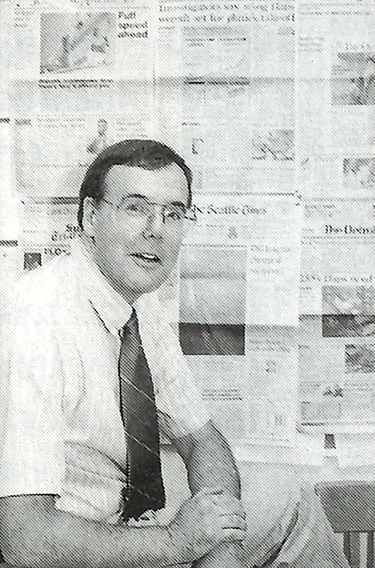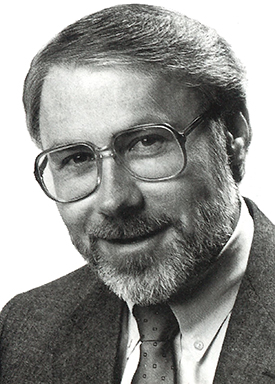Journalists, business minds split on how to keep newspapers healthy

UW Communications Professor Doug Underwood
The circle each other in the ring, making jabs, calculating right crosses, looking for that knockout punch. But this match isn’t Holyfield vs. Tyson in Madison Square Garden. This bout can be seen in newsrooms all over the United States.
In one corner are reporters steeped in traditional news values. In the other are editors trying to deal with a new set of grim economic realities. The stakes are the content, purpose and, ultimately, the very future of American newspapers.
UW Communications Professor Doug Underwood, a former reporter, describes the clash in American journalism in his new book, “When M.B.A.s Rule the Newsroom.”
Underwood is a veteran of the ring. Before joining the UW faculty in 1987, Underwood worked for the Seattle Times at a time of upheaval, when M.B.A. strategies came into vogue in the newsroom in the person of Michael Fancher, who is now a vice president and executive editor of the Seattle Times.
Fancher, who earned a master’s in business administration from the UW in 1986, typifies those in the other corner of the boxing ring. He is among the new breed of newspaper executives who keep one eye on the financial health of the paper and one eye on the news. Typically these editor-managers are schooled in management systems, marketing principles and journalism.
By applying the principles of American corporate management to the daily newspaper, these editors treat news like a product and readers like consumers. Shareholders and publishers cheer these gray-flannel warriors because they promote quality management and market-oriented journalism in a world traditionally inhabited by intrepid, passionate and cynical iconoclasts—a.k.a. reporters.
The editor-manager typically relies on focus groups and other marketing information to guide a paper to become, in Underwood’s words, “reader friendly.”
“Readers are being told lots about themselves—how they can cope, how they can evaluate their financial options, how their lives compare with those of the rich and famous—and the result is newspapers with less and less content,” he says.
The results of marketing are detrimental to news and news workers, Underwood thinks. Reporters are constrained in investigative efforts, space for hard news gets smaller, stories get fluffier and readers get less than they deserve.
“The homogeneity of thinking that produced the Big Mac is now at work in the packaging and marketing of everything from USA Today to many local newspapers,” Underwood declares. “The personality of newspapers is fast disappearing beneath a cascade of computer graphics, eye-catching packaging and marketing slogans. Stories are being written to ‘convey information,’ not to unearth hidden facts, develop important themes or delight with an intelligent turn of the phrase.”
Underwood typifies those in the reporters’ corner of the fight. On this December afternoon Underwood, dressed casually in a crew neck sweater, is quaffing a beer in a Queen Anne sports bar. In his early 40s, he “came up” in the era of Bob Woodward and Carl Bernstein, the Washington Post duo who broke the Watergate story. He speaks and writes with the intensity, passion and intelligence that has informed this country’s best reporting and writing.
But it has been a bruising experience for these reporters. That they remain in the ring, despite management-by-objectives, may be due to stubbornness, or maybe they are just too punch-drunk to leave. Their strategy seems to be to resist bureaucratic oversight, maintain the craft of writing and preserve the vigor of investigative reporting, despite the blows of the new, marketplace orientation.
The biggest punches are delivered by television. Editor-managers, frightened by TV viewer figures and the impact of USA Today, have adopted television tactics with the use of graphics, news “nuggets” and a more TV-like look.
If Underwood were a newspaper editor, he would order more coverage of television itself, including its news-gathering operations.

Michael Fancher
“I think local television is a blight on the social landscape, and that’s a story,” he says. “Newspapers shouldn’t be imitating television; they should be covering it.” If reporters are not asking questions about television as news, it’s hardly surprising. If Underwood is correct about the impact of M.B.A.s in the newsroom, journalists are encouraged to gather information rather than dig deep, write long and report creatively.
“Many journalists are finding it tougher to question authority out in the world when they are being pressured to become loyal corporate soldiers inside their organizations,” says Underwood.
Some newspapers have toned down investigative reporting as a result of the management style. In his book, Underwood quotes one investigative reporter who says, “The appetite these days is for fairly safe, less controversial, sociological stories. If you look across the country, you see papers doing a great job of covering prisons, and juvenile crime and child abuse. But you don’t see people asking how Exxon got to be bigger than five or six countries in the world.”
The M.B.A. approach is a response to stagnating circulation, declining advertising revenues and dipping profits. But the new style—and the hardships journalists undergo because of it—are all for naught anyway, if Underwood is correct. “It just doesn’t work and that’s the bottom line,” he remarks.
Between 1983 and 1993, the population of King County rose 21 percent. From September 1983, to September 1993, the Seattle Times daily circulation rose about 6 percent.
Though they are coming from the opposite sides of the ring, Underwood and Fancher agree on many of the newspaper industry’s ills. Fancher, especially, shows a passion for preserving newspapers and a commitment to news that is evenly matched with Underwood’s, albeit from another perspective.
Despite his M.B.A. reputation, Fancher doesn’t resemble the part. On a December morning he is dressed casually in a sweater and slacks. The 50-something Fancher looks like a newsroom editor, not a manager worried about the bottom line. His office walls scream news, not business. There are no flow charts; rather there are framed front pages from significant news days:
“Shuttle Explodes.” “Times Receives Pulitzer Prize.” “Gorbachev Back.” Oddly, it is his coffee cup that tips his visitor to a particular attitude. It says, “No Whiners.”
“Doug and I agree about the dangers of declining readership, inroads by other media, technical innovation and economic pressures. We agree on these dangers,” Fancher explains. “The question is, what do you do to protect the journalistic equation and remain financially viable? I can’t say, ‘I’ll fight the good fight to the death and someday we’ll turn off the lights.’ I am not a quitter.
“I think one of the things he (Underwood) misunderstands about my getting the M.B.A. was that my publisher and I were motivated to protect journalistic integrity by understanding the economics at work. Somebody in the newsroom has to be looking after this stuff. If not the editor, then who?”
Fancher says newspapers must go on the offensive. “The forces coming to bear on newsrooms are unstoppable. Putting your head in the sand isn’t going to help. You’ve got to develop new strategies. It wasn’t that I wanted it this way. It’s change or be changed. We can’t protect our principles from a defensive posture. Somebody will come in and tell us we’re history.”
To avoid becoming history, the Seattle Times went through a redesign under Fancher’s leadership. The new look reflects the belief that the customer, or reader, should come into the equation. Times focus groups found that one-quarter of the market were “junkies” who would read the paper regardless of content. One-quarter were hopeless; people who wouldn’t read the paper no matter what changes were made. The remaining 50 percent are the challenge. Half of this group are “at-risk” readers: people who want their news colorful and short, more like television. The other half want their newspaper to cover issues with more depth.
Fancher recalls one participant at a focus group who said he didn’t like the redesign because the new Seattle Times reminded him of USA Today and the New York Times. That response indicated to Fancher that the paper was on the right track in appealing to two disparate groups of readers.
For all their sparring, Underwood actually shares many of Fancher’s essential beliefs and has high praise for the Seattle Times. “I care about the Times and fundamentally value and respect it. It’s like being very hard on somebody you care deeply about. It’s excellent regional journalism. They have excellent reporters. They’ve improved their coverage of Boeing and the University of Washington. And it took guts on the part of the Times and Mike Fancher to break the Brock Adams story.” (The Times interviewed several women who accused former U.S. Senator Brock Adams of sexual harassment. Adams did not run for re-election in 1992 as a result of the investigative piece.)
Fancher says if there was one mistake he made in implementing “M.B.A. rule” in the Times newsroom, it was not communicating well enough and not listening to reporters.
“We’ve made some mistakes. But we had some real opening up. It needed to be okay for people to be afraid of change.” He adds that change just keeps happening, and he sees that continuing in the newsroom.
Ironically, the two contenders say they have the same solution to the problem—better journalism. The way to reach that destination is where the two part company. To Fancher, better journalism means offering more of what the readers want, reflecting the diversity of the community, and being the most complete, innovative, distinguished and interesting paper possible. In Fancher’s view, meeting readers’ needs and incorporating marketing principles isn’t a death knell for journalistic integrity, it isn’t even incompatible. “Let’s care enough about the readers to connect with them better,” he says.
Underwood takes a different track toward saving newspapers. “My solution is producing very high quality journalism. That’s a threat to people who realize that management [techniques] can’t produce it.” When M.B.A.s rule the newsroom, it’s “journalism through management and not through entrustment of very good reporters,” he adds. Victory will not go to those in the business school corner, he declares. “Ultimately, the fight will be fought in the arena of journalism.”